Rotating Stall Induced Non-Synchronous Blade Vibration Analysis for an Unshrouded Industrial Centrifugal Compressor
Abstract
:1. Introduction
2. Rotating Stall Identification and Resonance Condition for Impeller
2.1. Parameter Characterization of Rotating Stall
2.2. Identification of Stall Induced Impeller Vibration and Resonance
3. Test Facilities and Measurement Procedure
3.1. Centrifugal Compressor Test Rig
3.2. Data Acquisition
3.2.1. Unsteady Static Pressure Measurement
3.2.2. Strain Gauge and Tip Timing Measurement
4. Results and Discussion
4.1. Stall Induced Flow Instability Behavior during Throttling Process
4.2. Rotating Stall Induced Vibration Identification during Speed Ramp
4.3. Stall Parameters Identification Based on Circumferential Pressure Pulsation Signals
4.4. Vibration Quantification Based on Tip Timing Measurement
5. Conclusions
Author Contributions
Funding
Acknowledgments
Conflicts of Interest
References
- Krain, H. Review of Centrifugal Compressor’s Application and Development. J. Turbomach. 2005, 127, 25–34. [Google Scholar] [CrossRef]
- Singh, M.P.; Vargo, J.J. Reliability Evaluation of Shrouded Blading Using the SAFE Interference Diagram. J. Eng. Gas Turbines Power 1989, 111, 601–609. [Google Scholar] [CrossRef]
- Haupt, U.; Seidel, U.; Abdel-Hamid, A.N.; Rautenberg, M. Unsteady Flow in a Centrifugal Compressor with Different Types of Vaned Diffusers. J. Turbomach. 1988, 110, 293–302. [Google Scholar] [CrossRef]
- Day, I.J. Stall, Surge, and 75 Years of Research. J. Turbomach. 2015, 138, 011001. [Google Scholar] [CrossRef]
- Emmons, H.W.; Pearson, C.E.; Grant, H.P. Compressor Surge and Stall Propagation. Trans. ASME 1955, 77, 455–469. [Google Scholar]
- Greitzer, E.M. Surge and Rotating Stall in Axial Flow Compressors—Part I: Theoretical Compression System Model. J. Eng. Power 1976, 98, 190–198. [Google Scholar] [CrossRef]
- Greitzer, E.M. Surge and Rotating Stall in Axial Flow Compressors—Part II: Experimental Results and Comparison With Theory. J. Eng. Power 1976, 98, 199–211. [Google Scholar] [CrossRef]
- Cumptsy, N.A.; Greitzer, E.M. A Simple Model for Compressor Stall Cell Propagation. J. Eng. Power 1982, 104, 170–176. [Google Scholar] [CrossRef]
- Jansen, W. Rotating Stall in a Radial Vaneless Diffuser. J. Basic Eng. 1964, 86, 750–758. [Google Scholar] [CrossRef]
- Lennemann, E.; Howard, J.H.G. Unsteady Flow Phenomena in Rotating Centrifugal Impeller Passages. J. Eng. Gas Turbines Power 1970, 92, 65–72. [Google Scholar] [CrossRef]
- Abdelhamid, A.N. Analysis of Rotating Stall in Vaneless Diffusers of Centrifugal Compressors. In Proceedings of the International Gas Turbine Conference and Products Show, New Orleans, LA, USA, 10–13 March 1980; p. V01BT02A089. [Google Scholar] [CrossRef]
- Abdelhamid, A.N. Effects of Vaneless Diffuser Geometry on Flow Instability in Centrifugal Compression Systems. In Proceedings of the International Gas Turbine Conference and Products Show, Houston, TX, USA, 9–12 March 1981; p. V001T03A008. [Google Scholar] [CrossRef]
- Ferrara, G.; Ferrari, L.; Baldassarre, L. Rotating stall in centrifugal compressor vaneless diffuser: Experimental analysis of geometrical parameters influence on phenomenon evolution. Int. J. Rotating Mach. 2004, 10, 433–442. [Google Scholar] [CrossRef]
- Fujisawa, N.; Hara, S.; Ohta, Y. Unsteady behavior of leading-edge vortex and diffuser stall in a centrifugal compressor with vaned diffuser. J. Therm. Sci. 2016, 25, 13–21. [Google Scholar] [CrossRef]
- Fujisawa, N.; Inui, T.; Ohta, Y. Evolution Process of Diffuser Stall in a Centrifugal Compressor With Vaned Diffuser. J. Turbomach. 2018, 141, 041009. [Google Scholar] [CrossRef]
- Iwamoto, S.; Yoneda, K.; Tokuyama, S.; Higuchi, H. Impeller Stall Induced by Reverse propagation of Non-Uniform Flow Generated at Return Channel. In Proceedings of the 45th Turbomachinery & 32nd Pump Symposia, Houston, TX, USA, 12–15 September 2016; pp. 1–23. [Google Scholar] [CrossRef]
- Chen, J.; Hasemann, H.; Seidel, U.; Jin, D.; Huang, X.; Rautenberg, M. The Interpretation of Internal Pressure Patterns of Rotating Stall in Centrifugal Compressor Impellers. In Proceedings of the International Gas Turbine and Aeroengine Congress and Exposition, Cincinnati, OH, USA, 24–27 May 1993; p. V03AT15A043. [Google Scholar] [CrossRef]
- Seidel, U.; Chen, J.; Haupt, U.; Hasemann, H.; Jin, D.; Rautenberg, M. Rotating Stall Flow and Dangerous Blade Excitation of Centrifugal Compressor Impeller: Part 1—Phenomenon of Large-Number Stall Cells. In Proceedings of the International Gas Turbine and Aeroengine Congress and Exposition, Orlando, FL, USA, 3–6 June 1991; p. V001T01A044. [Google Scholar] [CrossRef]
- Hasemann, H.; Haupt, U.; Jin, D.; Seidel, U.; Chen, J.; Rautenberg, M. Rotating Stall Flow and Dangerous Blade Excitation of Centrifugal Compressor Impeller: Part 2—Case Study of Blade Failure. In Proceedings of the International Gas Turbine and Aeroengine Congress and Exposition, Orlando, FL, USA, 3–6 June 1991; p. V001T01A045. [Google Scholar] [CrossRef]
- Jenny, P.; Bidaut, Y. Experimental Determination of Mechanical Stress Induced by Rotating Stall in Unshrouded Impellers of Centrifugal Compressors. J. Turbomach. 2016, 139, 031011. [Google Scholar] [CrossRef]
- Mischo, B.; Jenny, P.; Mauri, S.; Bidaut, Y.; Kramer, M.; Spengler, S. Numerical and Experimental FSI-Study to Determine Mechanical Stresses Induced by Rotating Stall in Unshrouded Centrifugal Compressor Impellers. In Proceedings of the ASME Turbo Expo 2018: Turbomachinery Technical Conference and Exposition, Oslo, Norway, 11–15 June 2018; p. V07CT36A015. [Google Scholar] [CrossRef]
- Vahdati, M.; Simpson, G.; Imregun, M. Unsteady Flow and Aeroelasticity Behavior of Aeroengine Core Compressors During Rotating Stall and Surge. J. Turbomach. 2008, 130, 031017. [Google Scholar] [CrossRef]
- Sorokes, J.M.; Marshall, D.F.; Kuzdzal, M.J. A Review of Aerodynamically Induced Forces Acting on Centrifugal Compressors, and Resulting Vibration Characteristics of Rotors. In Proceedings of the 45th Turbomachinery & 32nd Pump Symposia, Houston, TX, USA, 12–15 September 2016; pp. 1–23. [Google Scholar]
- Giachi, M.; Ferrara, G.; Tapinassi, L.; Belardini, E.; Bianchini, A.; Vannini, G.; Ferrari, L.; Biliotti, D. A Systematic Approach to Estimate the Impact of the Aerodynamic Force Induced by Rotating Stall in a Vaneless Diffuser on the Rotordynamic Behavior of Centrifugal Compressors. J. Eng. Gas Turbines Power 2013, 135, 112502. [Google Scholar] [CrossRef]
- Biliotti, D.; Bianchini, A.; Vannini, G.; Belardini, E.; Giachi, M.; Tapinassi, L.; Ferrari, L.; Ferrara, G. Analysis of the Rotordynamic Response of a Centrifugal Compressor Subject to Aerodynamic Loads Due to Rotating Stall. J. Turbomach. 2015, 137, 021002. [Google Scholar] [CrossRef]
- Levy, Y.; Pismenny, J. The Number and Speed of Stall Cells During Rotating Stall. In Proceedings of the Volume 6: Turbo Expo 2003, Parts A and B, Atlanta, GA, USA, 16–19 June 2003; pp. 889–899. [Google Scholar] [CrossRef]
- Mehdigholi, H. Forced Vibration of Rotating Discs and Interaction with Non-Rotating Structures. Ph.D. Thesis, University of London, London, UK, 1991. [Google Scholar]
- Bianchini, A.; Biliotti, D.; Giachi, M.; Belardini, E.; Tapinassi, L.; Ferrari, L.; Ferrara, G. Some Guidelines for the Experimental Characterization of Vaneless Diffuser Rotating Stall in Stages of Industrial Centrifugal Compressors. In Proceedings of the ASME Turbo Expo 2014: Turbine Technical Conference and Exposition, Düsseldorf, Germany, 16–20 June 2014; p. V02DT42A028. [Google Scholar] [CrossRef]


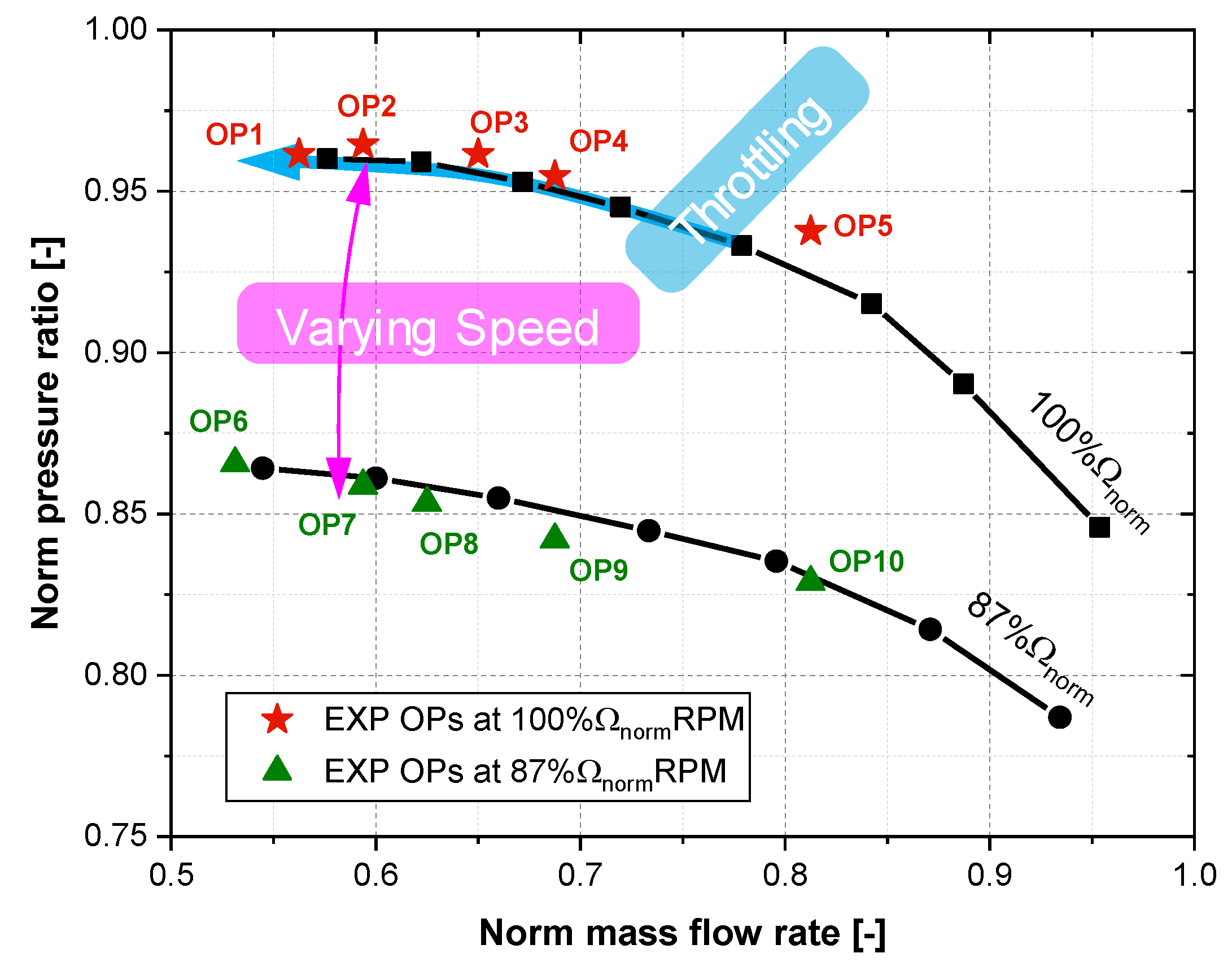

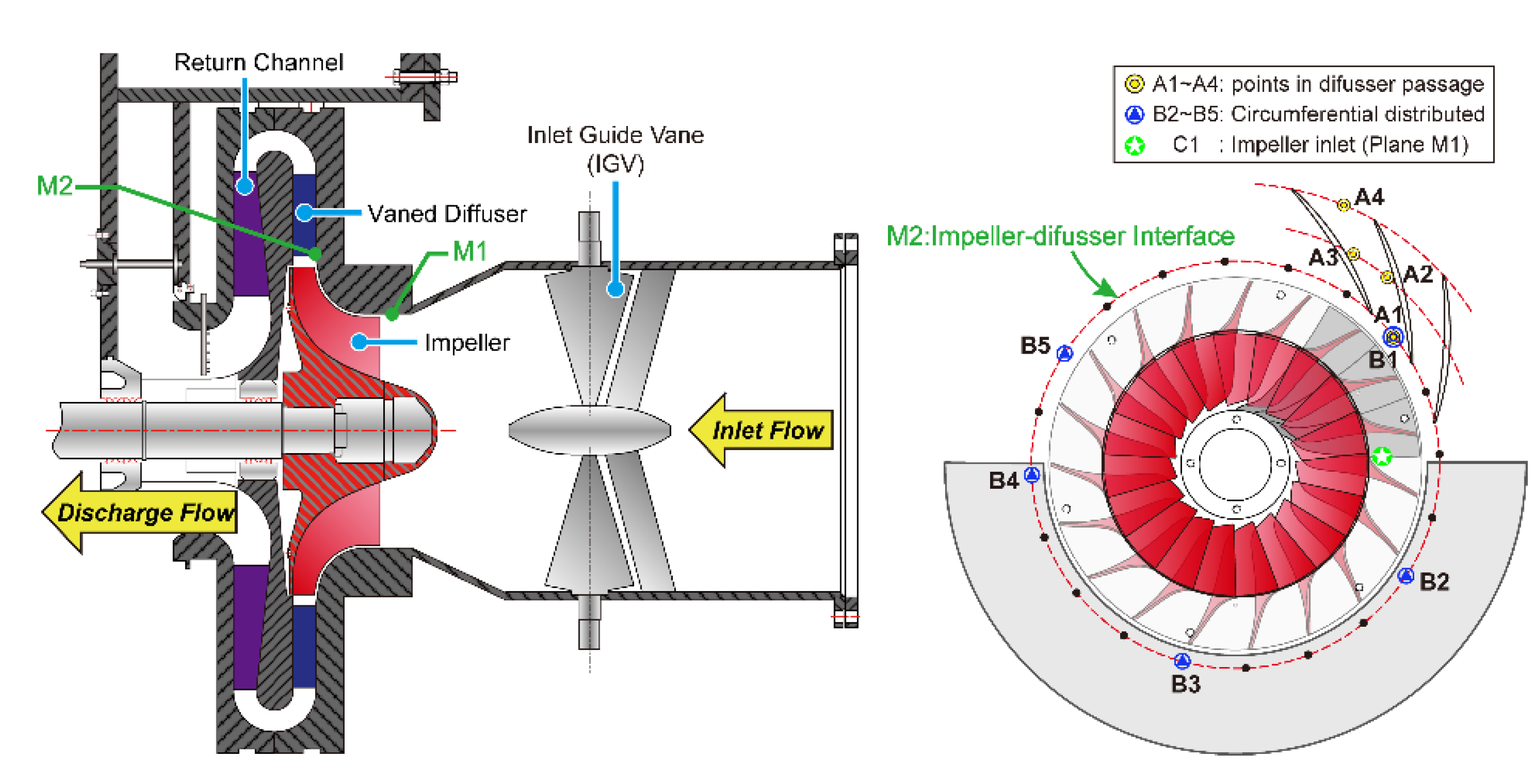

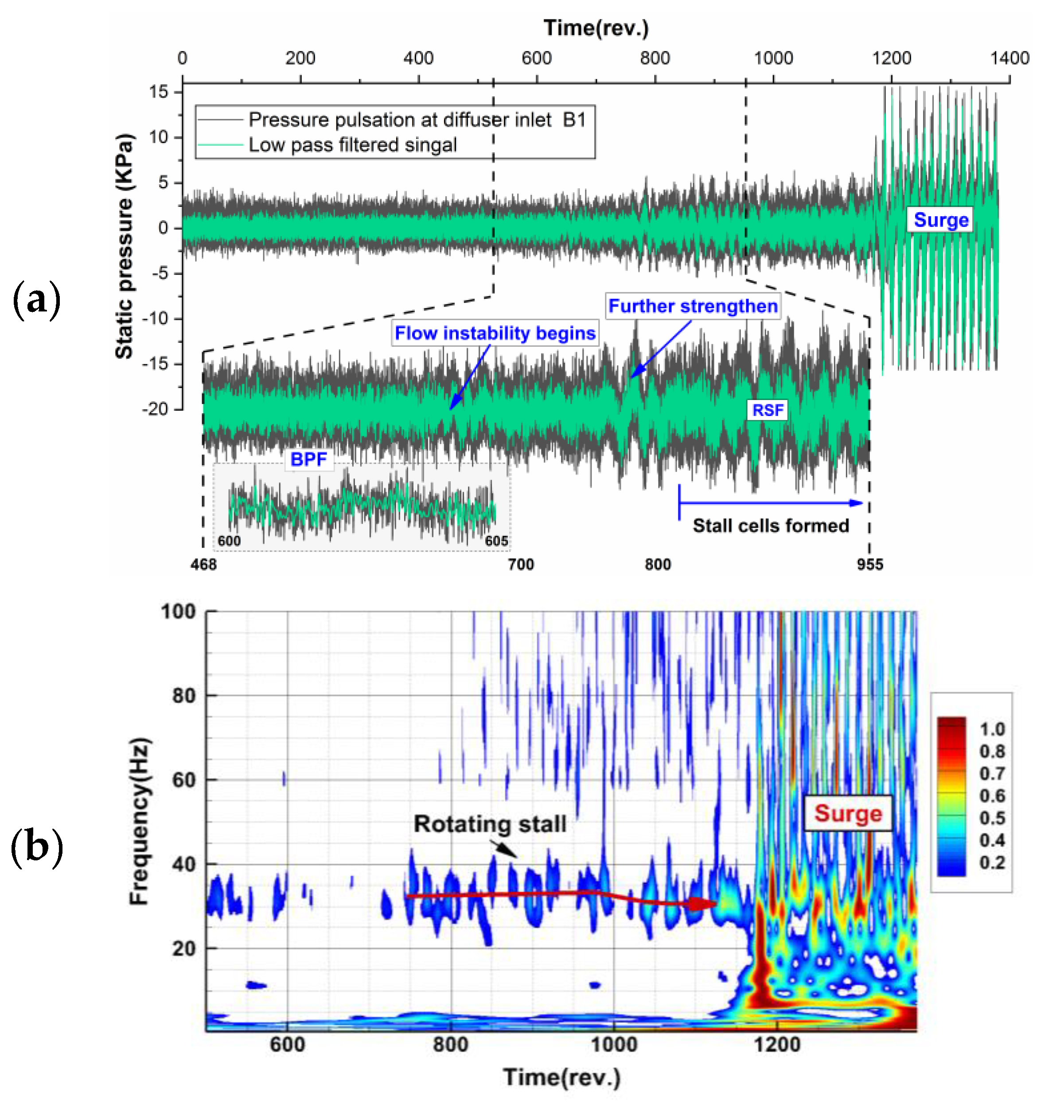

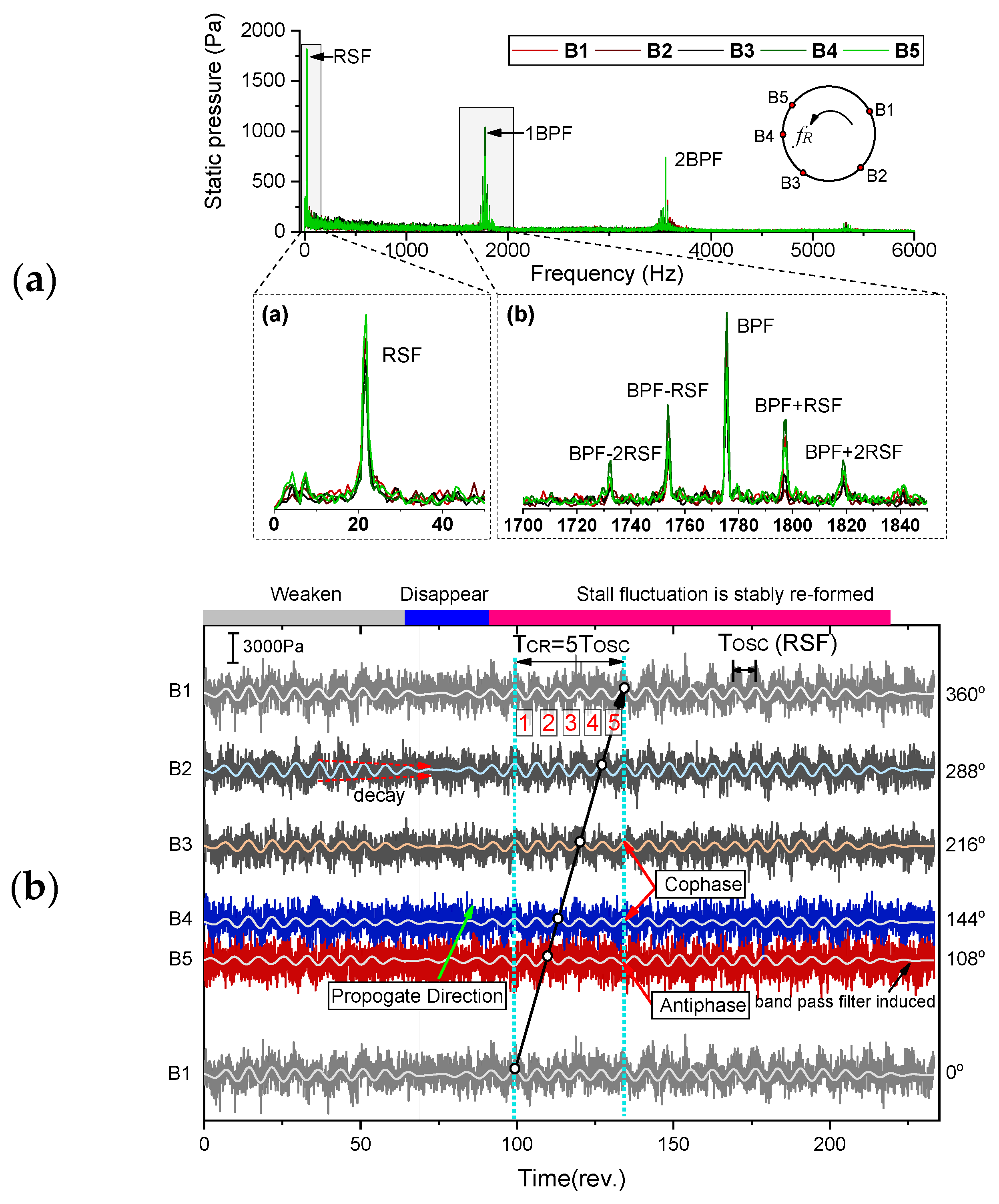

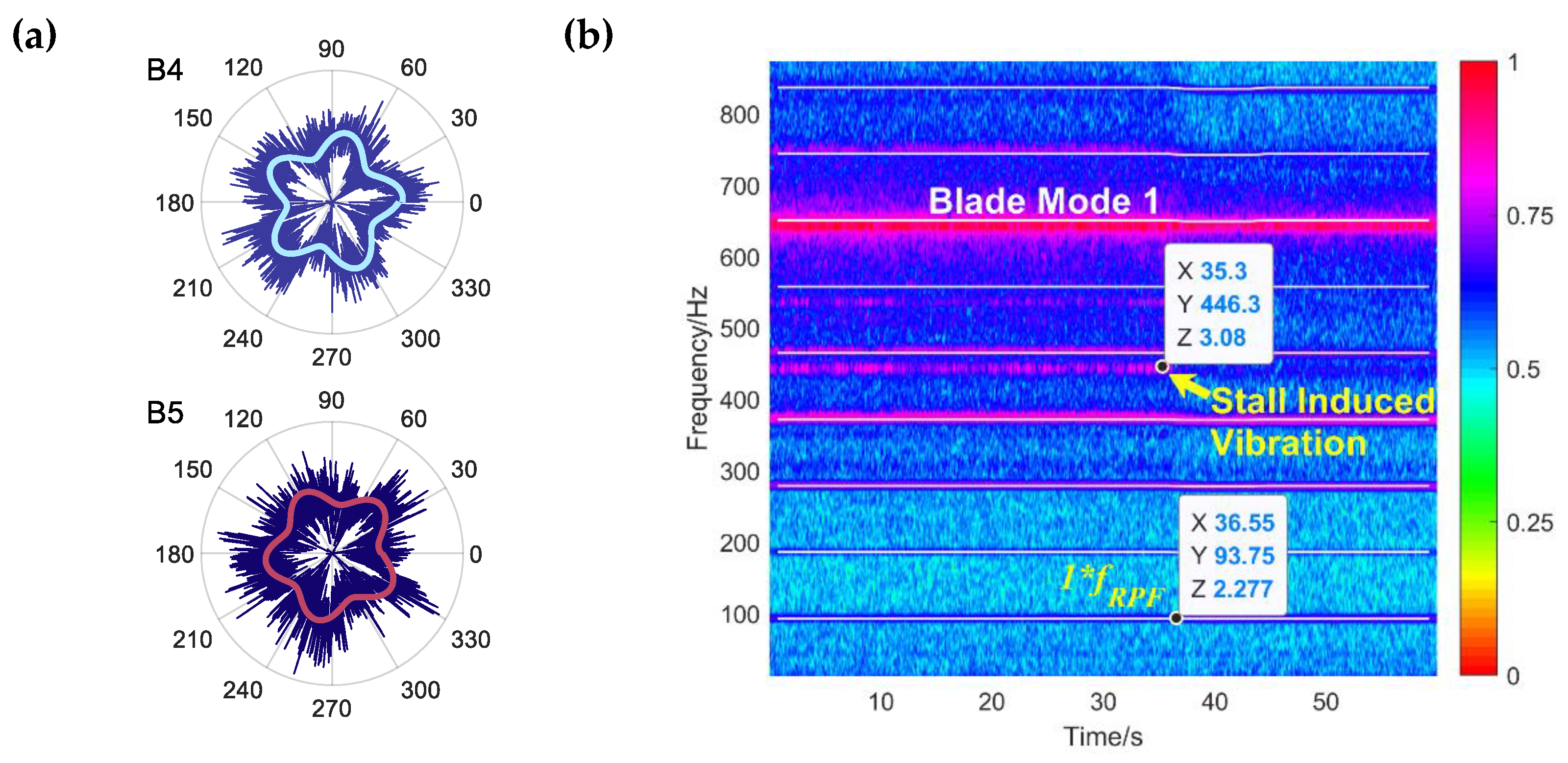

| Parameters | Value |
|---|---|
| Number of inlet guide vanes | 11 |
| Number of impeller blades | 19 |
| Number of diffuser vanes | 20 |
| Number of return channel vanes | 18 |
| Impeller outlet diameter D2 (mm) | 810 |
| Impeller outlet width b2 (mm) | 57.5 |
| Diffuser inlet diameter D3 (mm) | 900 |
| Diffuser outlet diameter D4 (mm) | 1242 |
© 2019 by the authors. Licensee MDPI, Basel, Switzerland. This article is an open access article distributed under the terms and conditions of the Creative Commons Attribution (CC BY) license (http://creativecommons.org/licenses/by/4.0/).
Share and Cite
Zhao, X.; Zhou, Q.; Yang, S.; Li, H. Rotating Stall Induced Non-Synchronous Blade Vibration Analysis for an Unshrouded Industrial Centrifugal Compressor. Sensors 2019, 19, 4995. https://doi.org/10.3390/s19224995
Zhao X, Zhou Q, Yang S, Li H. Rotating Stall Induced Non-Synchronous Blade Vibration Analysis for an Unshrouded Industrial Centrifugal Compressor. Sensors. 2019; 19(22):4995. https://doi.org/10.3390/s19224995
Chicago/Turabian StyleZhao, Xinwei, Qiang Zhou, Shuhua Yang, and Hongkun Li. 2019. "Rotating Stall Induced Non-Synchronous Blade Vibration Analysis for an Unshrouded Industrial Centrifugal Compressor" Sensors 19, no. 22: 4995. https://doi.org/10.3390/s19224995





